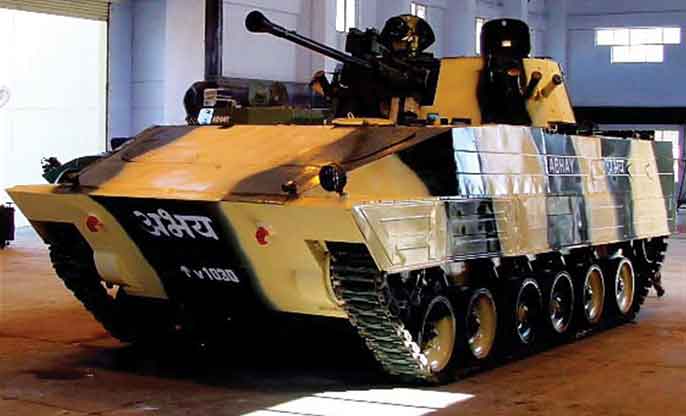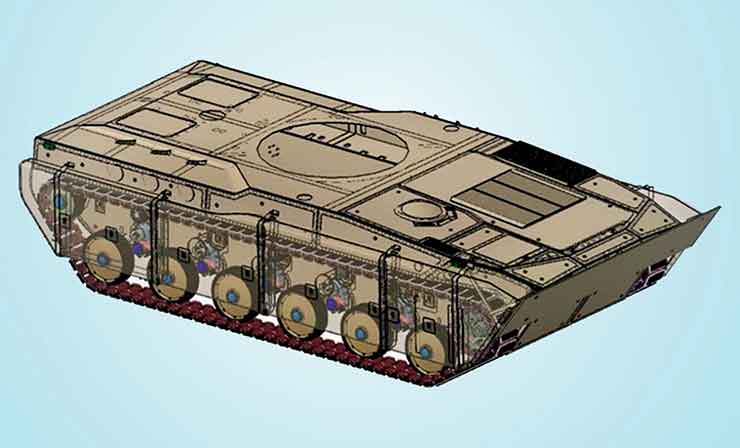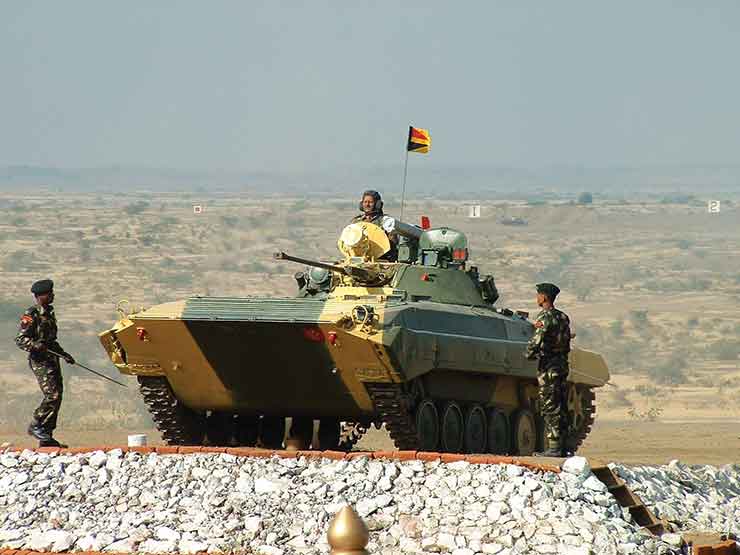
THE DRDO began developing Abhay, an Infantry Combat Vehicle (ICV), in the late 1990s and the design work was completed by 2001. Abhay is a pre-technology demonstrator to develop and test technologies to be used in a futuristic ICV (FICV) to replace the BMP-II in service with the army. The pre-production prototype was rolled out in June 2005 and development of the first armoured prototype has been in progress. India imported hundreds of BMP-I from Soviet Union between 1976 and 1982. With useful life of 10-15 years, their life expired during period 1991-1997.
Production in India of BMP-1 with imported engines and opto-electrical devices costing Rs 16.50 crore was sanctioned in June 1984. Under another agreement in February 1985, import of BMP-II and its technology was approved costing Rs 57.17 crore. Production was to commence in 1987-88 and sanctioned capacity achieved by 1992-93; but this could not be met due to various reasons. In 1990, the production plan was reduced to 231 and 1991-92 onwards to 150 due to budgetary constraints. The production targets for 1991-92 was restricted to 120 and 100 vehicles from 1992-93 onwards.
Production of the BMP-2, called Sarath, was undertaken at 100 per year. By 2012 approximately, 1900 BMP-2/2K were in service with the army (now around 2500) and were likely to remain operational till 2017. On October 29, 2015, MoD approved acquisition of 149 BMP-2 to be built in the country under license from Russia, with India spending over $140 million; the potential contract stipulated licensed assembly in India at the facilities of one of the plants of the Ordnance Factory Board (OFB), a state holding company for the production of ammunition, weapons and vehicles.

The details of the contract were to be discussed during then Defence Minister Manohar Parrikar’s visit to Moscow. In 2017, Army conceived ‘Project FICV 2017’ on private-public partnership basis under Defence Procurement Procedure 2008 (DPP-2008), which laid down “Make” procedure for developing “high-tech, complex systems” through Indian industry. Based on the GSQR, the Expression of Intent (EOI) issued in 2009 laid down that the FICV will be operated by three crew members, and carry seven additional soldiers with combat loads; it must provide protection from bullets fired by 14.5mm calibre weapons; it must be amphibious, i.e. capable of floating in water; it must be air-transportable, which would imply a maximum weight of 18-20 tons; and it must have a grenade launcher, co-axial machine gun, and be capable of firing anti-tank missiles (fire and forget type). MoD was to fund 80 per cent of the development cost; selected contractor was to pay 20 per cent, and FICV must have indigenous content of at least 50 per cent.
The Expression of Interest (EoI) was sent to Mahindra Defence Systems, Tata’s, L&T and Ordnance Factory Board (OFB) in 2009, each of whom had submitted their technical and commercial bids. Considering army’s requirement for better and advanced replacements for upgraded BMP-2, FICV project was to be put on fast track. The army was looking at production of 3,000 FICVs to replace the upgraded BMPs at a cost of $10 billion. The project got bogged down because Russia offered the BMP-3 but was not accepted since indigenous firms had invested heavily in the project.
Finally, two developing agencies (DAs) are to be shortlisted who would be required to produce five prototypes in the laid down time frame for user trials. Attempt by OFB to partner DRDO as design partner was not accepted on grounds that eventually DRDO will be responsible for technology evaluation and approval.
As per earlier reports, the project was not to be a winner-take-all competition since MoD planned to retain two production lines, the winner given 65-70 per cent of the order; the runner-up to build 30-35 per cent of the army’s requirement of FICVs, provided the latter company agreed to build the winning design at the same cost as the winner. With two assembly lines operating, India’s private defence players expected that the FICV contract will create an eco-system of suppliers extending far beyond the winner of the contract.
With change of the government in 2014, Project FICV was restarted afresh to include indigenous firms like Bharat Forge, Punj Lloyd, Force Motors and Ashok Leyland. These additional indigenous firms were included through a fresh “acceptance of necessity”, as approved by the MoD. The foreign firms that were likely to go in for joint ventures (JVs) with Indian partners reportedly included Rosoboronexport (Russia), General Dynamics (USA), Rafael (Israel), Nexter and Thales (France), Krauss-MaffeiWegmann (Germany) and Doosan Group of Republic of Korea.

After approval of the ‘acceptance of necessity’ and inclusion of more domestic companies, detailed reports were to be submitted to MoD by end 2014. Accordingly, a second EoI was issued to 10 vendors on July 16, 2015, seeking firm proposal, capital expenditure and other details. Simultaneously, MoD also approved that OFB with two private firms would make the prototype of the FICV. The two DAs were then to be shortlisted to build the prototypes. However, all this got log-jammed in bureaucratic bottlenecks, corporate rivalry and controversies.
On February 15, 2016, MoD received response to the EoI from L&T, Mahindra Defence Systems, Reliance Defence, Consortium of Tata Motors and Bharat Forge, OFB and Consortium of Tata Power SED and Titagarh Wagons Limited. But more hurdles came up with private domestic companies objecting to MoD nominating state-owned OFB as one of the DA, especially since DPP 2008, according to which the procurement is being done states that the DPB would select the best “two” DAs out of the short-listed companies of the design and development of the prototype.
In mid-2017, the US also offered trilateral collaboration of US-India-Israel JV for producing the FICV under the DTTI. Media reports of June 2017 indicated that the FICV project is likely to be taken up by the Defence Procurement Board (DPB) headed by the Defence Secretary. A MoD source was quoted as saying, “As per the procedure, once the DPB addresses some issues related to the FICV project raised by certain companies earlier this year, it will go to the DAC.” Apparently many issues, even procedural, were hampering progress of this project.
Post issue of second EoI, Mahindra Defence Systems had lodged a complaint questioning empanelment of three other vendors, issue of a second EoI, and questioning MoD on the project status. MoD referred the complaint to a panel of Independent Expert Monitors (IEMs). In February 2018, it was reported that the IEMs found the evaluation process for selecting firms to produce FICV prototypes correct and the FICV project would finally move.
But that is not to be. MoD has now sent the FICV proposal back to the army to study the possibility of shifting it under the ‘Make II’ category. Under the Make II category, there is no funding required from the MoD, whereas under the Make category the MoD has to provide 90 per cent of funds up to prototype stage. As per the Chapter III of DPP-2016, the ‘Make’ procedure for indigenous design, development and manufacture of defence equipment/ weapon systems was simplified in 2016. And a new sub-category, Make II (industry funded), was introduced.
No government funding is mentioned for the development of the prototype albeit there is an assurance of orders after successful development and trials. Incidentally, Mahindra Defence Systems, Reliance Defence and Engineering and Titagarh, Wagons had submitted their plans for the FICV as required under Make II category. Others had not because none had been asked to submit their proposals accordingly.
The question here is that after DPP 2016 and the Strategic Partnership Model (SPM) came into force, why were all firms / consortiums that had responded to the second EoI not asked to submit their proposals under Make II category? There obviously is no accountability and sense of responsibility. By throwing the file back at the army, it is quite likely that the whole process may recommence.

With the US-India-Israel JV proposed by the US, even a third EoI could be floated. The irony is that the BMP-II has no night fighting capability. It was hoped that the FICV will at least commence replacing the BMP-II by 2017, with phasing out of BMP-II commencing in 2018. In 2017, MoD awarded Rs 2,400 crore contract to upgrade 693 BMP-2s with night fighting capabilities but the army is yet to receive first of the upgraded BMP-2.
Follow up of the first EoI was stunted because of perceived inconsistencies in evaluation of EoI responses between the IPMT and MoD’s Acquisition Wing; MoD scrapped the process saying it would restart it in nine months but took three years before the project was restarted in 2015. With the current impasse, vendors selection may take another 3-4 years after the prototypes are trial evaluated.
Therefore, induction of the FICV will likely commence only around 2029-30, provided there are no more hurdles. This indeed is a sad state of affairs. Yet the government is unconcerned that MoD is manned purely by bureaucrats; sans military professionals – an irony peculiar to India.
– The author is veteran Lieutenant General









